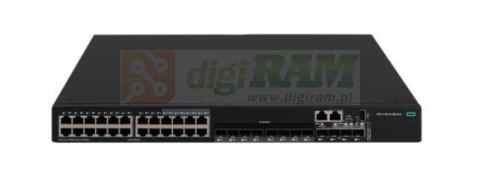-
Koszyk jest pusty
-
x
Do bezpłatnej dostawy brakuje
-,--
Darmowa dostawa!
Suma Netto
0,00 zł
Suma Brutto
0,00 zł
Cena uwzględnia rabaty

0
twój koszyk
0,00 zł
-
Koszyk jest pusty
-
x
Do bezpłatnej dostawy brakuje
-,--
Darmowa dostawa!
Suma Netto
0,00 zł
Suma Brutto
0,00 zł
Cena uwzględnia rabaty
-
Przełącznik 5140-24G-4SFP+ 1-slot HI R9L61A


Symbol:
R9L61A
| Wpisz swój e-mail |
| Wysyłka w ciągu | 1 - 7 dni |
| Cena przesyłki | 15 |
| Dostępność |
|
| Zostaw telefon |
Seria przełączników HPE FlexNetwork 5140 HI zapewnia wysoką dostępność i skalowalność w warstwie dostępowej średnich i dużych sieci kampusowych przedsiębiorstw.
Przełączniki te zapewniają szybką łączność i elastyczność dzięki łączom nadrzędnym 10GbE i portom combo. Obsługa modułów dodatkowych zwiększa pojemność dzięki dodatkowym funkcjom. Jest to bardzo ekonomiczny przełącznik z licznymi funkcjami, takimi jak DRNI i IRF dla zwiększenia odporności, funkcje QoS dla większej niezawodności, iNQA dla wydajności sieci i wglądu w pojemność w czasie rzeczywistym.
| Informacje o produkcie | |
| Klasa przełącznika | Zarządzalny |
| Zastosowanie | Średnie i duże firmy (powyżej 16 portów) |
| Warstwa przełączania | L3 L2 |
| Architektura sieci | GigabitEthernet |
| Liczba portów 10/100/1000 Mbps | 24 |
| Liczba portów 10Gb | 4 |
| Liczba portów COMBO | 8 |
| Liczba portów SFP+ | 4 |
| Port konsoli | Tak |
| Przepustowość | 288 Gb/s |
| Prędkość przekazywania | 180 Mpps |
| Rozmiar tablicy adresów MAC | 32000 |
| Bufor pakietów | 4 MB |
| Obsługa ramek Jumbo | Tak |
| Rozmiar ramki Jumbo | 8 KB |
| Obsługiwane protokoły i standardy |
|
| QoS |
|
| Zarządzanie, monitorowanie, konfiguracja |
|
| Typ obudowy | Rack (Switche/UPS) |
| Wentylator | Tak |
| Zasilacz | Wewnętrzny |
| Pobór mocy | 95 W |
| Zasilanie |
100240 VAC, znamionowe (90264 VAC, maks.) -48 do -60 VDC, znamionowe (od -36 do -72 VDC, maks.) (w zależności od wybranego zasilacza) |
| Wymiary |
440.0 x 360.0 x 43.6 mm |
| Waga | 6.7 kg |
| Oznaczenia | |
Nie ma jeszcze komentarzy ani ocen dla tego produktu.
